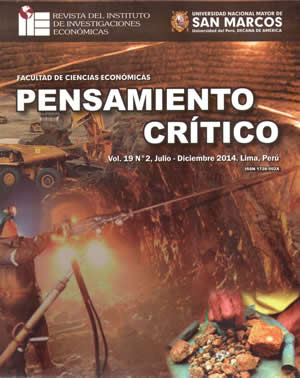The administration of private pension funds in peru facing international financial crises (1993: 2013)
DOI:
https://doi.org/10.15381/pc.v19i2.11107Keywords:
Pension funds, financial crisis, investment risk managementAbstract
The levels of risk generated by the financial crisis could affect substantially the economic and social well-being of contributors to a pension fund people whether this private or public. The aim of this article is the study of the administration of private funds pensions of Peru and the measurement of its relationship with the seven international financial crises developed between 1993 and 2013: subprime mortgage Crisis, Mexican, Asian, Russian, Brazilian, Argentine, and Europe’s crisis. A correlational descriptive study was conducted to test the bonds of relationship between the yield of Peru pension funds and stock indices of economies in crisis according to each case, and its corresponding temporality. To determine the financial efficiency of the Peruvian pension funds investments, it was necessary to calculate the index of Sharpe’s main Latin America pension funds whereas horizons of five, ten and fifteen years, for greater perspective. It was found that administration of pension funds had a significant correlation with the crises in Asia, Russia, Brazil, Argentina, USA and the crisis of Europe, except the Mexican crisis. The financial crisis with the highest degree of linear Association (Dear by the Pearson coefficient) and greater adverse impact was the mortgage crisis subprime United States. It was found that the results of efficiency financial (according to the Sharpe index) of pension funds in Peru were below the average in the region.Downloads
Published
Issue
Section
License
Copyright (c) 2014 Wilmer Flórez G.

This work is licensed under a Creative Commons Attribution-NonCommercial-ShareAlike 4.0 International License.
THE AUTHORS RETAIN THEIR RIGHTS:
a. The authors retain their trademark and patent rights, and also on any process or procedure described in the article.
b. The authors retain the right to share, copy, distribute, execute and publicly communicate the article published in Pensamiento Crítico (for example, place it in an institutional repository or publish it in a book), with recognition of its initial publication in Pensamiento Crítico.
c. The authors retain the right to make a subsequent publication of their work, to use the article or any part of it (for example: a compilation of their works, notes for conferences, thesis, or for a book), provided they indicate the source of publication (authors of the work, journal, volume, number and date).






